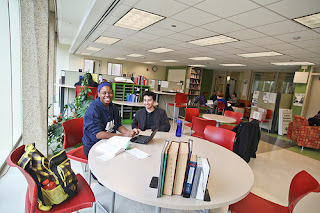The overall vibe I got from the students around those buildings was very calm and relaxing. Several of them were lying on the grass in the shade or sitting on benches, enjoying the warm weather. In the middle of the three halls, there is a small area of benches, and past Douglas and Lincoln Hall is a small area of greenery full of grass, plants and trees. Conversations ranged to all sorts of topics, of which I only overheard two. The first was a girl talking to her friend about a professor and then her schedule. The second conversation was from two ladies walking and talking about some kind of international organization (I didn't catch any specific details). No one ever seemed to be in a rush. Everyone was walking leisurely (by themselves or in groups) to their next class, going home, or meeting up with other friends. I didn't see very many teachers around and the few that I did see were the only ones rushing to get to their classroom. For those who don‘t want to be outside, the halls are their havens. They consist of several lounge areas (also called oases) where students sit and quietly do homework or relax. Also, there are many computer labs that are used for classes, doing homework, or simply browsing the internet. .
The halls are more recent additions to the campus. The are named after important people: Lincoln after Abraham Lincoln, Douglas after Stephen A. Douglas, and Grant after the U.S. general and president Ulysses Grant. The architecture of the buildings is very modern with full-wall windows, well-working air conditioning, and new furniture. All three halls are connected by enclosed walkways. Douglas and Lincoln Hall don’t have a large purpose besides containing areas for classrooms and lounging, and computer labs. The Grant Hall, on the other hand, is very important because the Writing Center is located in it. Here, students can get help from professors anytime, but for more one-on-one time (50 minutes per appointment), it‘s vital to make an appointment ahead of time. Many students take advantage of this building because it’s receiving free tutoring. Did I mention it’s free?

The Grant, Douglas, and Lincoln Hall
The Writing Center in Grant Hall
The Art and Architecture Building, on the other hand, stands as one of the monuments from the past. It was built in 1967 by Walter Entsch, who also built many other buildings on the campus. His vision was to move away from the “boredom of the box” and create a building in a double-helix (rotating squares outward from the center).This is the only interesting aspect of AA because the inside overall isn't very interesting. It only consists of several floors with long tables. Even so, the building stands as a unique form of architecture and artwork. The current building is only 40% of the original plan, and the rest was never built. The rest of it was suppose to be the classrooms, but for some reason it was never added. Students who want to major in Art and Architecture will spend most of their time here.

Double Helix
Left: Plans for the AA (dotted line indicates what wasn't built. Right: The AA building today.
After getting over the fright of starting in a much larger school and getting used to the campus, it doesn't seem so big and scary. I adjusted very well by using the campus map and asking other students for directions. Everyone is very friendly and as long as they’re not in a rush, they’ll gladly help. Just do what I did and take some time to explore the campus so you know where everything is. Even when you feel like you know where everything is, it never hurts to have a campus map, just in case.





No comments:
Post a Comment